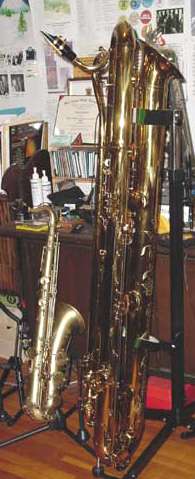Tubax
 | |
| Woodwind instrument | |
|---|---|
| Classification | |
| Hornbostel–Sachs classification |
422.212-71 (Single-reeded aerophone with keys) |
| Inventor(s) | Adolphe Sax |
| Developed | 28 June 1846[1] |
| Playing range | |

 | |
| Related instruments | |
|
Military band family:
Orchestral family: Other saxophones:
| |
| Musicians | |
| More articles | |
The tubax is a modified saxophone developed in 1999 by the German instrument maker Benedikt Eppelsheim. It is available in both E♭ contrabass and B♭ or C subcontrabass sizes. Its name is a portmanteau of the words "tuba" and "sax". The first size of tubax to be developed was the E♭ contrabass. It has the same register as a regular contrabass saxophone but is much more compact due to its tubing being folded more times. While the timbre of the E♭ tubax is more focused and compact than that of the full-sized contrabass saxophone, it still blends well with other sizes of saxophones and can be played with surprising agility compared to its size. The subcontrabass tubax uses a baritone saxophone or bass saxophone mouthpiece. While several B♭ subcontrabasses are already in use, only one C model has been manufactured. It was sold to Thomas Mejer of Switzerland in July 2002; he has recorded on it with Peter A. Schmid as the "Two Tubax Duo."
The tubax has had debate over whether it is really in the saxophone family. Its bore is not as wide as other saxophones that size are, and the tubing is very thin compared to other saxes. Some authorities classify it as its own family of instruments, while others consider it in the saxophone family. Also, the tubax is a lot like a double reed instrument family called a sarrusophone. The sarrusophone's range is the same as a saxophone, while some have a high G, though the tubax has a much wider bore compared to the latter instrument. Lastly, the tubax's sound is a little bit "honkier" than the average saxophone.
Notable tubax performers
- Serge Bertocchi
- Marcus Weiss
- Paul Cohen
- Petr Dvořák
- Jay C. Easton
- Randy Emerick
- Blaise Garza
- Vinny Golia
- Mats Gustafsson
- Masayuki Kuroda
- Jarno Sarkula
- Steffen Schorn
- Attilio Berni*
External links
- Benedikt Eppelsheim Website
- Fred Bayer's Tubax Page
- Article about CD featuring tubax
- Jay C. Easton's BBb Tubax page
- tubax -- earthquake saxophone Masayuki Kuroda's page
Listening
- MP3 of a tubax being played by Randy Emerick, with the Jerry Fischer Orchestra, Hollywood Florida (playing "Stardust", arr. by Mike Lewis)
- MP3 of two B♭ subcontrabass tubaxes (overdubbed), playing movement 1 of Duet for Basses by Walter S. Hartley, performed by Jay C. Easton
References
- ↑ "June 28, 1846: Parisian Inventor Patents Saxophone". Wired.com. Retrieved 14 February 2011.